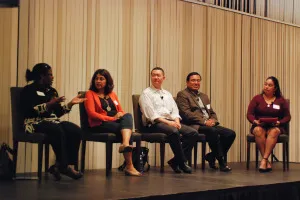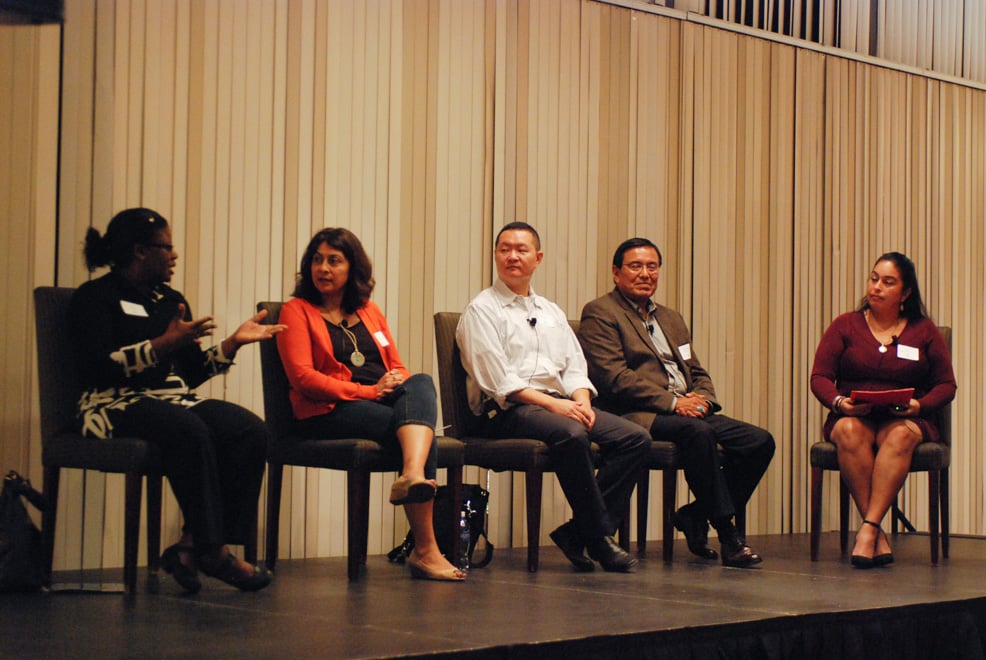
Students and alumni presented “25 Years: Honoring Student Activism and the Legacy of the 1989 Takeover” on Thursday, an event to commemorate the student activism that led to the promotion of multicultural integration on campus. Organizers also hoped to inspire students to think about what it means to take over their education today.
History of the takeover
This event celebrated the 1989 takeover, in which 55 students from ethnic groups around campus were arrested after confronting the University’s failure to address racial injustices by storming former Stanford president Donald Kennedy’s office.
“The main purpose of the takeover,” said Jessica Reed ’16, Black Student Union co-president and student performer, “was really trying to create institutional change to go along with the change that was occurring demographically in terms of the students on campus.”
Among other requests, student groups from the Asian American Community Center, Native American Cultural Center and other organizations, demanded that the University expand on current ethnic studies classes, add new ethnic studies programs, increase funding for cultural centers and hire more faculty of color.
Event program
The 25th-anniversary commemoration began with a welcome from Jan Barker Alexander, associate dean of student affairs, who addressed how the past can fuel the present.
Following her speech was the student production “Takeover ’89,” directed, written and produced by Ken Savage ’14. The play depicted the motivations behind the takeover, the timeline of events on May 19, 1989, and how current students can respond to these past events.
The event followed with a historic perspective presented by Clay Carson, a history professor during the time of the takeover. Carson reflected on his thoughts towards the legacy of the takeover, in which he stated that “the [takeover] was one of the proudest moments of my life…we were inspired by the students.”
Lastly, students had a chance to interact with alumni who had participated in the ’89 takeover during the panel discussion titled “Panel: Alumni Reflections.” Alumni Richard Suh ’90, Cheryl Taylor ’90, Gina Hernandeze-Clarke ’89 and William McCabe ’89 answered questions regarding their reflections on the takeover and advice for current students.
Connecting alumni and current students
Both current students and alumni, many of whom participated in the takeover 25 years ago, attended the affair. Students and alumni were able to reflect on how actions taking place years ago were able to affect the current state of Stanford education.
“We would have no way of anticipating that our actions 25 years ago would have any impact on students today,” Suh said. “It feels really fulfilling; you certainly feel a sense of satisfaction that what you did at one point in time made a big difference.”
“I can’t separate my personal tie to the takeover,” said Hye Jeong Yoon ’14, a student performer in “Take Over ’89.” “All Stanford students benefited, but being a CSRE [Comparative Studies in Race and Ethnicity] major, I know that I for one would not be the same person if I didn’t make relationships with professors who were hired directly because of this takeover. I am the direct beneficiary of this takeover.”
Among the alumni who attended was Louis Jackson ’91, who was singled out for more serious charges than other students for his actions.
Students inspired for action
At the event, students were able to reflect on their own empowerment and voices by learning about what students in their own shoes achieved 25 years ago.
“It’s the past reconnecting with the present. We notice that, yeah, stuff has changed, but there’s also so much more,” Priscilla Agbeo ’18 said. “[Alumni] being here just showed me that the fire is still ablaze, that there’s still more to be done, and it is possible to do something because they’ve gotten that far from where they were.”
In the panel discussion with alumni, moderator Alma Medina ’92 stated, “I was enough, I was enough to make a difference — and other people were also enough, so when you put that together, you can really make a difference.”
One key feature of the student performance was the separation of parts between the performers. Half of the actors portrayed the students who were participating in the takeover and activism 25 years ago, while the other half played current students, responding to these past events.
“The performance portrays history in terms of before and after, but also shows that change is a continuum and how even though the takeover happened in 1989,” Reed said. “Changes have still been happening incrementally since then, but that we still have room to grow in 2014… but just knowing that we stand on the shoulders of giants.”
“Self determination for our education”
The theme for the takeover of ’89 was “self determination for our education.” At the event, both students and alumni were challenged to think about what this phrase means for them today.
“This phrase really meant being critical of what you’re being taught and taking control of what you’re being taught and having a say of what you’re being taught,” said Suh.
“To me, self determination for our education means taking ownership of your history. We should be able to learn about it from our lens, not a westernized lens. There’s often a lot of miseducation because it’s in a westernized lens if it’s not in the perspectives that we necessarily would stand for,” Jade Verdeflor ’17 said.
Cultural communities coming together
This event was a joint venture between the various culture groups around campus. The participating groups were the Asian American Activities Center, El Centro Chicano y Latino, Black Community Services Center and the Native American Culture Center. This collaboration of cultural groups mirrors the spirit of unity that incited the takeover, in which many student groups came together to create one force.
“In the takeover, I saw the solidarity between the groups,” Verdeflor said. “I guess in my experience in organizing I’m very focused on my personal group, so seeing these different groups coming together was very inspiring.”
Not only did this collaboration to create the event incite meaningful communication, but also highlighted the common goals of different community groups around campus.
“To be able to put this 10-minute piece together that meant so much to all our communities, and whose legacy has affected us today was amazing,” Savage said. “It’s cool to put this script together and to share one another’s history in ways that students were not particularly knowledgeable about.”
Mandate for change
This event provided an opportunity for students and alumni to reflect the legacy of the takeover and assess the ways in which the University has kept its promises.
After the takeover, the University instituted a mandate for change that addressed the protesting students’ concerns. They promised to add new ethnic studies programs and expand current ones, increase funding for all cultural centers including full-time needs for each community center, and hiring at least three faculty of color to teach courses about communities in color each year.
“We want to be able to provide the opportunity for the audience to reflect on how the school has been able to fulfill the demands that were stated in that mandate and to just really also think about the current issues that are really taking ground at Stanford,” Reed said.
This post has been updated. It previously stated that 55 students participated. In fact, 55 were arrested and nearly 100 participated. It also stated that Louis Jackson was the only student arrested. In fact, he was among many arrested students but was singled out for more serious charges.
Contact Stephanie Zhang at szhang3 ‘at’ stanford.edu.
